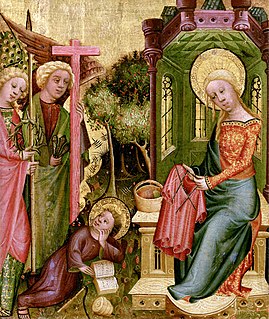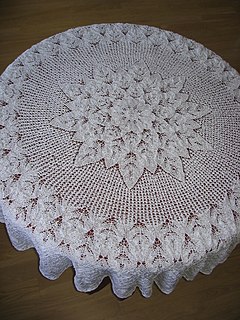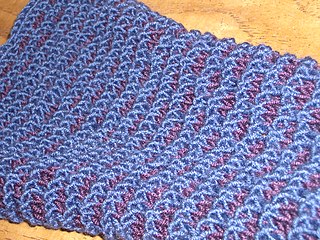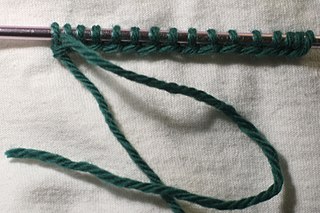Related Research Articles

Knitting is a method by which yarn is manipulated to create a textile or fabric. It is used in many types of garments. Knitting may be done by hand or by machine.

The Aran jumper is a style of jumper that takes its name from the Aran Islands off the west coast of Ireland. A traditional Aran Jumper usually is off-white in colour, with cable patterns on the body and sleeves. Originally the jumpers were knitted using unscoured wool that retained its natural oils (lanolin) which made the garments water-resistant and meant they remained wearable even when wet.

Knitting is the process of using two or more needles to loop yarn into a series of interconnected loops in order to create a finished garment or some other type of fabric. The word is derived from knot, thought to originate from the Dutch verb knutten, which is similar to the Old English cnyttan, “to knot”. Its origins lie in the basic human need for clothing for protection against the elements. More recently, hand knitting has become less a necessary skill and more a hobby.
Intarsia is a knitting technique used to create patterns with multiple colours. As with the woodworking technique of the same name, fields of different colours and materials appear to be inlaid in one another, fit together like a jigsaw puzzle.

A knitting machine is a device used to create knitted fabrics in a semi or fully automated fashion.

Elizabeth Zimmermann was a British-born hand knitting teacher and designer. She revolutionized the modern practice of knitting through her books and instructional series on American public television.

Lace knitting is a style of knitting characterized by stable "holes" in the fabric arranged with consideration of aesthetic value. Lace is sometimes considered the pinnacle of knitting, because of its complexity and because woven fabrics cannot easily be made to have holes. Famous examples include the Orenburg shawl and the wedding ring shawl of Shetland knitting, a shawl so fine that it could be drawn through a wedding ring. Shetland knitted lace became extremely popular in Victorian England when Queen Victoria became a Shetland lace enthusiast. Her enthusiasm resulted i.a. in her choosing knitted lacework for presents; e.g. when in ca. 1897 the Queen gave a lace shawl as a present to American abolitionist Harriet Tubman. From there, knitting patterns for the shawls were printed in English women's magazines where they were copied in Iceland with single ply wool.

Cable knitting is a style of knitting in which textures of crossing layers are achieved by permuting stitches. For example, given four stitches appearing on the needle in the order ABCD, one might cross the first two the next two, so that in subsequent rows those stitches appear in the new order CDAB.

Slip-stitch knitting is a family of knitting techniques that use slip stitches to make multiple fabrics simultaneously, to make extra-long stitches, and/or to carry over colors from an earlier row.

In knitting, casting on is a family of techniques for adding new stitches that do not depend on earlier stitches, i.e., having an independent lower edge. In principle, it is the opposite of binding off, but the techniques involved are generally unrelated.
In knitting, binding off, or casting off, is a family of techniques for ending a column of stitches. Binding off is typically used to define the final edge of a knitted fabric, although it may also be used in other contexts, e.g., in making button holes. In principle, binding off is the opposite of casting on, but the techniques are generally not mirror images of one another. Sometimes, however, they can produce a mirror image appearance.

Brioche knitting is a family of knitting patterns involving tucked stitches, i.e., yarn overs that are knitted together with a slipped stitch from the previous row. Such stitches may also be made by knitting into the row below and dropping the stitch above.

Double knitting is a form of hand knitting in which two fabrics are knitted simultaneously on one pair of needles. The fabrics may be inseparable, as in interlock knitted fabrics, or they can simply be two unconnected fabrics. In principle, an arbitrary number of fabrics can be knitted simultaneously on one pair of knitting needles with yarns, as long as one is careful.
Shannon Okey is an American writer and knit designer.
Knitting clubs are a feature of the 21st-century revival of hand knitting which began in America and has spread to most of Europe. Despite the name, knitting clubs are not limited to knitting; both crochet-centered and knit-centered clubs are collectively called "knitting clubs." While knitting has never gone away completely, this latest reincarnation is less about the make-do and mend of the 1940s and 1950s, and more about making a statement about individuality and developing a sense of community.
Hand knitting is a form of knitting, in which the knitted fabric is produced by hand using needles.

Cowichan knitting is a form of knitting characteristic of the Cowichan people of southeastern Vancouver Island, British Columbia. The distinctively patterned, heavy-knit Cowichan sweaters, popular among British Columbians and tourists, are produced using this method. Cowichan knitting is an acculturated art form, a combination of European textile techniques and Salish spinning and weaving methods. From this union, new tools, techniques and designs developed over the years.
Aran knitting patterns are heavily textured knitting patterns which are named after the Aran Islands, which are located off the west coast of Ireland from County Galway and County Clare. The patterns are knitted into socks, hats, vests, scarves, mittens, afghans, pillow covers, and, most commonly, sweaters.
Marie Wallin is a British fibre artist and fashion designer known for her colorful fair isle designs. After working as a Head Designer for Rowan for many years, she became a successful freelance knitwear designer.
References
- 1 2 Melanie Falick (2005). America Knits. Artisan. pp. 37–. ISBN 978-1-57965-287-6.
- ↑ Knit 'n Style February 2009 page 14
- ↑ Knitting Nature page 5
- ↑ Vogue Knitting International, Winter 1990-91, Article: "Norah Gaughan's Knitting Equations' page 28
- ↑ Clara Parkes (2011). The Knitter's Book of Socks: The Yarn Lover's Ultimate Guide to Creating Socks That Fit Well, Feel Great, and Last a Lifetime. Potter Craft. pp. 200–. ISBN 978-0-307-58680-3.
- ↑ "Norah's Knits: À bientôt". 21 April 2014.
- ↑ Gaughan, Norah (2006). Knitting Nature: 39 Designs Inspired by Patterns in Nature . ISBN 1584794844.
- ↑ Lisa Souza (10 May 2011). 10 Secrets of the LaidBack Knitters: A Guide to Holistic Knitting, Yarn, and Life. St. Martin's Press. pp. 161–. ISBN 978-0-312-61200-9.